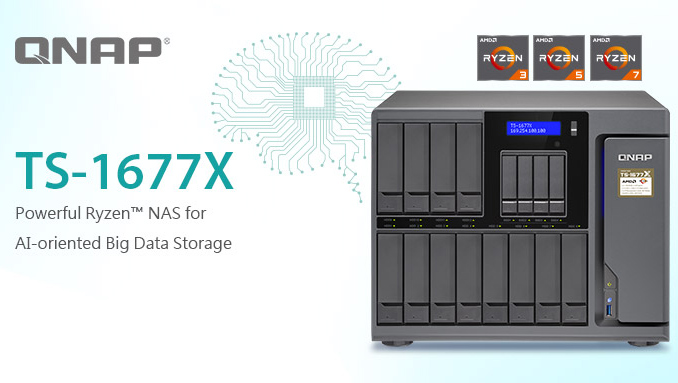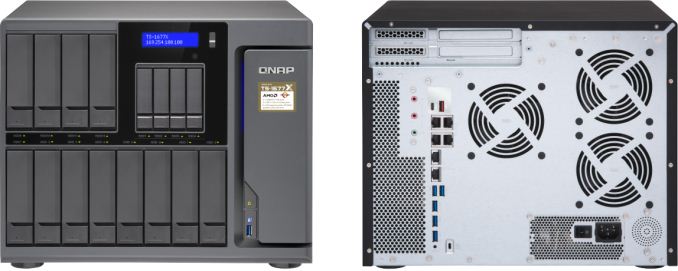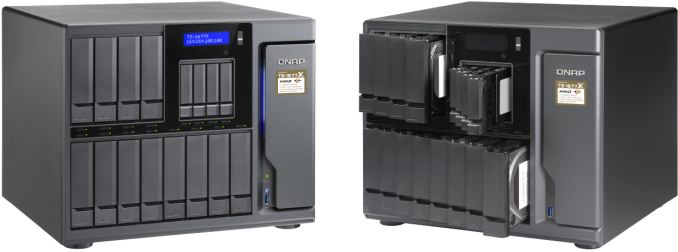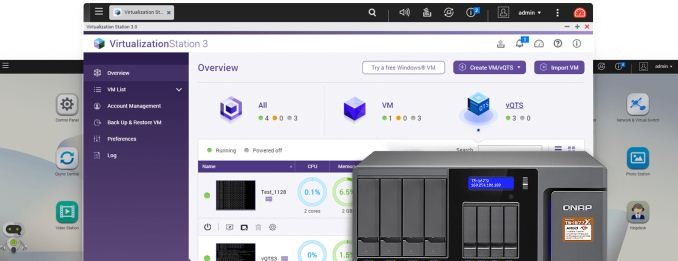QNAP Launches 16-Bay AMD Ryzen-Based TS-1677X NAS with 10 GbE
by Anton Shilov on May 25, 2018 2:00 PM EST
QNAP this week introduced its new family of 16-bay enterprise-class NAS based on AMD’s Ryzen processors. The new TS-1677X devices support Qtier automatic data tiering and SSD caching technology as well as 10 GbE and Multi-Gig Ethernet connectivity. Interestingly, QNAP ships the NAS with with its QuAI developer package that can be used to optimize the NAS for AI, ML, and DL applications.
The QNAP TS-1677X is powered by AMD’s Ryzen 1000-series processors with up to eight cores & AES-NI encryption engine, as well as up to 64 GB of DDR4 memory. The NAS features 12 3.5-inch hot-swappable bays for high-capacity hard drives, and four 2.5-inch hot-swappable bays for SSDs to be used for caching. In addition, the NAS has three PCIe expansion slots (one PCIe 3.0 x8, one PCIe 3.0 x4, one PCIe 2.0 x4) that can be used to install additional high-performance M.2 SSDs using special add-on adapter cards, additional 10GbE/40GbE networking card(s), or a GPU to accelerate highly-parallel workloads such as those used for AI, ML, and DL applications. For connectivity, the device uses two 10GBASE-T network controllers (presumably from Aquantia) that support 10 GbE, 5 GbE, 2.5 GbE, 1 GbE, and 100 MbE speeds over conventional cables (so presumably a controller from Aquantia, unless Intel has something unannounced). In addition, the system has two GbE headers, and eight USB 3.0 Type-A/Type-C ports.
The key feature of the QNAP TS-1677X is the combination of formidable compute performance (a CPU with up to eight cores and a GPU for highly-parallel apps) and storage capabilities (12 3.5-inch 14 TB HDDs can store 168 TB of data) that can be used for traditional NAS use-models as well as emerging applications, including but not limited to video streaming, video surveillance, AI, ML, DL and so on.
Like other Ryzen-based NAS from QNAP, the the QNAP TS-1677X runs the company’s QTS 4.3 operating system that supports a variety of storage specific functionality, including RAID (RAID 0, 1, 5, 6, 10, 50, 60, JBOD), Qtier technology that routinely arranges regularly used file/data into tiers (by moving repeatedly used data to SSDs), encryption, snapshots, Qsync cross-platform file sharing (for Apple, Windows, and Linux machines), one touch copy, and so on. The QTS 4.3 also supports first-party and third-party apps that further enhance functionality of the product.
Meanwhile, the QTS Virtualization Station can run multiple virtual Windows/Linux/Unix machines on a NAS (the QNAP TS-1677X is VMware, Citrix, Microsoft Hyper V, and Microsoft Windows Server 2016 ready). Moreover, the new NAS supports vQTS that allows to run multiple virtual QTS systems on one NAS.
| QNAP TS-1277, TS-877 and TS-677 Specifications | |||||
| TS-1677X- 1700-64G |
TS-1677X- 1700-16G |
TS-1677X- 1600-8G |
TS-1677X- 1200-4G |
||
| CPU | Model | Ryzen 7 1700 | Ryzen 7 1700 | Ryzen 5 1600 | Ryzen 3 1200 |
| Cores | 8C/16T | 8C/16T | 6C/12T | 4C/4T | |
| Freq. | 3.0 - 3.7 GHz | 3.0-3.7 GHz | 3.2 - 3.6 GHz | 3.1 - 3.4 GHz | |
| L2 | 4 MB | 4 MB | 3 MB | 2 MB | |
| L3 | 16 MB | 16 MB | 16 MB | 8 MB | |
| TDP | 65 W | ||||
| Encryption Accel. | AES-NI | ||||
| Memory | Speed | DDR4-2400, dual-channel | |||
| Capacity | 64 GB (4×16 GB) |
16 GB (2×8 GB) |
8 GB (2×4 GB) |
4 GB (1×4 GB) |
|
| Bays | 12 × 3.5", 4 × 2.5" | ||||
| M.2 Slots | Using add-on-cards | ||||
| Storage interface | SATA 6 Gbps | ||||
| Ethernet | 2×GbE, 2×10/40 GbE (integrated) | ||||
| PCIe Slots | 1 × PCIe 3.0 x8 1 × PCIe 3.0 x4 1 × PCIe 2.0 x4 |
||||
| Audio | 1 × speakers 1 × audio out 2 × audio in |
||||
| USB | 7 × USB 3.0 Type-A 1 × USB 3.0 Type-A |
||||
| Other I/O | Monochrome backlit LCD display, IR receiver, voice allert, buzzer, etc. | ||||
| Dimensions | Height | 303.84 mm | 11.96" | |||
| Width | 369.9 mm | 14.56" | ||||
| Depth | 319.8 mm | 12.59" | ||||
| PSU | 550 W | ||||
| OS | QNAP QTS 4.3 | ||||
| MSRP | ? | ? | ? | ? | |
QNAP will offer four models of the TS-1677X NAS with various CPUs and different amount of memory. The manufacturer did not disclose prices, but since we are talking about enterprise-grade NAS, they are not going to be low.
Related Reading
- QNAP Launches TS-963X NAS: x86 NAS With 9 Bays & 10 GbE/Multi-Gig Ethernet
- QNAP Begins to Ship AMD Ryzen-Based TS-x77 Series NAS: 6, 8, 12 Bays
- QNAP Launches TS-1277 NAS Powered by AMD's Ryzen CPUs: 12 Bays, 64 GB DDR4, Starts at $2,299
- QNAP at CES 2017 - Thunderbolt 3 and Xeon D NAS Units, Residential Gateways, and More
- Synology at CES 2017 - RT2600ac Wi-Fi Router, DSM Value Additions, and New Business NAS Units
- Netgear Expands ReadyNAS Lineup with Intel Denverton Atom Platform
Source: QNAP













21 Comments
View All Comments
The Chill Blueberry - Friday, May 25, 2018 - link
Are those socketed ryzen chip? Because if so, I don't see why they wouldn't go for the 2000 series processors if they are pretty much the same but better latency overall. I feel like a NAS could really use the latency improvement. But I don't really know what I'm talking about. I've never used one personally.DanNeely - Friday, May 25, 2018 - link
They probably got a discount of some sort for buying old stock. Not like a few hundred MHz is going to make a huge difference either way.Ian Cutress - Friday, May 25, 2018 - link
These systems are designed 6-8 months previous and have a 3-5 year shelf life. It's the sort of industry that goes with what is out and sustainable at the time of design, rather than predicting what might be coming and designing for that.beginner99 - Friday, May 25, 2018 - link
my inner nerd says very cool devices. In reality I have 0 need for this and obviously lack the money. The drives alone...valinor89 - Saturday, May 26, 2018 - link
Forget the drives, fully populating that much memory must be quite expensive!mooninite - Friday, May 25, 2018 - link
QNAP... these devices should be avoided. Security-hole ridden junk. https://blog.talosintelligence.com/2018/05/VPNFilt...DigitalFreak - Friday, May 25, 2018 - link
Oh do shut up. They've already patched it, and it's not like no other company has ever had a security flaw.UpSpin - Saturday, May 26, 2018 - link
They patched it a year ago already! Long before Cisco Talos became aware of this threat.nexsuslab - Saturday, May 26, 2018 - link
Sorry but I still think that an "enterprise" class product with only one onboard not redundant and removable power supply is not acceptable !!heffeque - Saturday, May 26, 2018 - link
Buy two... problem solved!